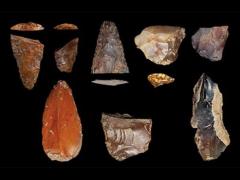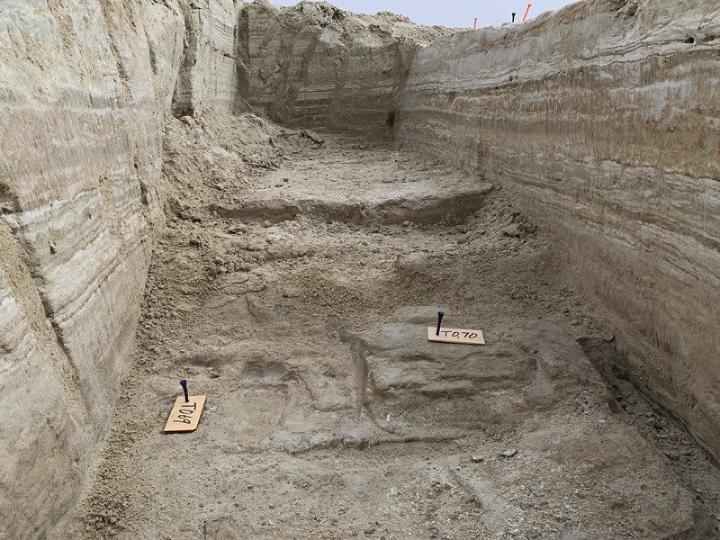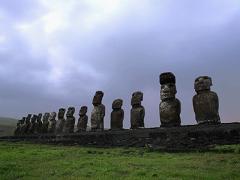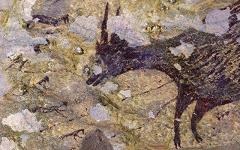 |
Canku Ota
|
 |
|
(Many Paths)
|
||
|
An Online Newsletter
Celebrating Native America
|
||
|
September 2021 - Volume
19 Number 9
|
||
|
|
||
|
Ancient Footprints
Could Be Oldest Traces Of Humans In The Americas
|
||
|
by Ewen Callaway - Nature
|
||
|
Children left tracks
in New Mexico around 22,500 years ago — thousands of years
before most scientists thought humans settled in North America.
White Sands National Park, in southern New Mexico, is known for chalk-coloured dunes that stretch for hundreds of square kilometres. But at the height of the last Ice Age, the region was wetter and grassier. Mammoths, giant sloths and other animals walked the muddy shores of shallow lakes that grew and shrank with the seasons. And they had company. In a landmark study published on 23 September in Science, researchers suggest that human footprints from an ancient lakeshore in the park date to between 21,000 and 23,000 years old. If the dating is accurate — which specialists say is likely — the prints represent the earliest unequivocal evidence of human occupation anywhere in the Americas.
“The evidence is very convincing and extremely exciting,” says Tom Higham, an archaeological scientist and radiocarbon-dating expert at the University of Vienna. “I am convinced that these footprints genuinely are of the age claimed.” The dates raise questions about when and how humans from Siberia settled in the region, with evidence growing that they skirted the Pacific coast while inland routes were entrenched in ice. The authors of the study say the footprints give credence to contentious evidence of even earlier signs of settlement in the Americas. “The paper makes a very compelling case that these footprints are not only human, but they’re older than 20,000 years,” says Spencer Lucas, a palaeontologist at the New Mexico Museum of Natural History & Science in Albuquerque. “That’s a game-changer.” Rocky evidence For decades, archaeologists associated the earliest Americans with 11,000–13,000-year-old stone spear points and other vestiges of ‘Clovis’ culture (named after another New Mexico site, but found throughout North America). The dates coincide with the recession of a continent-size glacier, which created an ice-free corridor through central Canada. The discovery of numerous 'pre-Clovis' archaeological sites, from Alaska to the tip of South America, dating to as old as 16,000 years, sowed doubts about the ‘Clovis-first’ hypothesis and argued for a coastal migration route from Siberia. Research journals are dotted with claims of even earlier sites, including a controversial Nature paper that put humans in California 130,000 years ago. But many of these claims have been discounted because of the equivocality of the evidence: rocks potentially mistaken for tools, marks on animal bones that might have been made by natural processes — or diggers, in the case of the California claim — rather than butchery.
White Sands is filled with human and animal fossil footprints — in 2018, the same team that found the tracks in the latest paper documented a giant sloth hunt on a dried-up lake bed known as a playa. But these tracks are notoriously difficult to date, says study co-author Matthew Bennett, a geoscientist at Bournemouth University in Poole, UK, who specializes in the study of fossil footprints. “Every time you uncover something it’s potentially a different age. Dating is a nightmare.” Ancient seeds In 2019, study co-author David Bustos, an archaeologist and resource manager at White Sands, identified a site on the playa that had tracks that led right into layers of rock-hard sediment. The rock contained seeds of spiral ditchgrass (Ruppia cirrhosa), an aquatic plant that could be carbon-dated to determine the age of the tracks. “That’s the holy grail of trying to date footprints,” says Bennett. He and his colleagues weren’t surprised when radiocarbon dating by researchers at the US Geological Survey in Denver, Colorado, determined that the seeds were between 21,000 and 23,000 years old, because a previous small-scale excavation had dated the sediment to around the same time. But Bennett says the team knew that claims of human occupation at this age would draw extreme scrutiny.
So they attempted to address factors that could skew the seeds’ ages. The most likely was a phenomenon whereby organisms incorporate carbon that has leached into the water from nearby rocks, such as calcium carbonate in limestone. Such carbon sources tend to be much older than the carbon in Earth’s atmosphere. The researchers say such ‘reservoir effects’ are unlikely. They dated hundreds of seeds in different sediment layers and their ages fell into line, with older seeds at the bottom, younger on top. If the seeds had incorporated old carbon, there would probably have been more variation, says co-author Daniel Odess, an archaeologist at the US National Park Service in Washington DC. At a site in the region that didn’t have any footprints, spiral ditchweed seeds date to the same age as charcoal in the same layer — which is not subject to reservoir effects. “I really think those ages are okay,” says Thomas Stafford, an experimental geochronologist at Stafford Research Laboratories in Lafayette, Colorado. Even a 1,000-year error wouldn’t tarnish the importance of the footprints, he points out. “Whether people were here 20,000, or 22,000, or 19,000 years ago, does not change their incredible story,” Stafford adds. “We have human footprints.” Teenage tracks The team determined that the several dozen tracks probably belonged to numerous individuals, mostly children and teenagers. “To me this makes perfect sense,” says Odess. “When I was young I was always heading to the water. Stream, river, pond, whatever it was. Given the chance, I would probably walk in mud more than dry ground.” Karen Moreno, a palaeoichnologist at Austral University of Chile in Valdivia, has no doubt that the tracks are human. She isn’t yet convinced that they were mostly made by children, because these estimates are based on the statures of modern people. But she says the tracks could shine a light on the earliest humans in America. “This older community most probably had a different and complex way of life.”
Now that there is strong evidence that humans settled the Americas more than 20,000 years ago, researchers should grapple with the consequences, says Bennett. He hopes the White Sands footprints will force researchers to reconsider sites that have more equivocal evidence of early human occupation. David Meltzer, an archaeologist at Southern Methodist University in Dallas, Texas, is convinced by the White Sands footprints, but disagrees that they give credence to the more controversial sites. However, if stone tools or other artefacts associated with the track-makers could be discovered, this could allow such connections to be drawn, Meltzer adds. The footprints make it “extremely likely” that the ancestors of the White Sands humans and other early settlers travelled along the Pacific coast, says Higham. The next step will be to identify the people who arrived through these Ice Age voyages, he adds. “An urgent research priority is not just to find footprints such as these, but the remains of the people who made them.” |
||||||||||
|
|
|
|
||
|
|
||
| Canku Ota is a free Newsletter celebrating Native America, its traditions and accomplishments . We do not provide subscriber or visitor names to anyone. Some articles presented in Canku Ota may contain copyright material. We have received appropriate permissions for republishing any articles. Material appearing here is distributed without profit or monetary gain to those who have expressed an interest. This is in accordance with Title 17 U.S.C. Section 107. | ||
|
Canku Ota is a copyright ©
2000 - 2021 of Vicki Williams Barry and Paul Barry.
|
||
 |
 |
|
|
The "Canku
Ota - A Newsletter Celebrating Native America" web site and
its design is the
|
||
|
Copyright ©
1999 - 2021 of Paul C. Barry.
|
||
|
All Rights Reserved.
|
||




